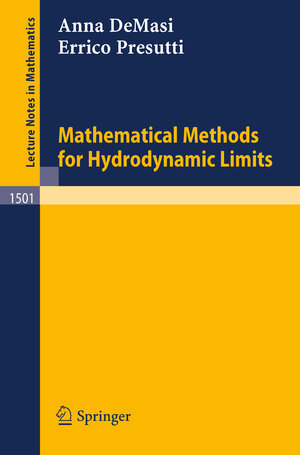
×
![Buchcover ISBN 9783540550044]()
Entropy inequalities, correlation functions, couplings
between stochastic processes are powerful techniques which
have been extensively used to give arigorous foundation to
the theory of complex, many component systems and to its
many applications in a variety of fields as physics,
biology, population dynamics, economics, ...
The purpose of the book is to make theseand other
mathematical methods accessible to readers with a limited
background in probability and physics by examining in detail
a few models where the techniques emerge clearly, while
extra difficulties arekept to a minimum.
Lanford's method and its extension to the hierarchy of
equations for the truncated correlation functions, the
v-functions, are presented and applied to prove the validity
of macroscopic equations forstochastic particle systems
which are perturbations of the independent and of the
symmetric simple exclusion processes. Entropy inequalities
are discussed in the frame of the Guo-Papanicolaou-Varadhan
technique and of theKipnis-Olla-Varadhan super exponential
estimates, with reference to zero-range models. Discrete
velocity Boltzmann equations, reaction diffusion
equations and non linear parabolic equations are considered,
as limits of particles models. Phase separation phenomena
are discussed in the context of Glauber+Kawasaki evolutions
and reaction diffusion equations. Although the emphasis is
onthe mathematical aspects, the physical motivations are
explained through theanalysis of the single models, without
attempting, however to survey the entire subject of
hydrodynamical limits.
between stochastic processes are powerful techniques which
have been extensively used to give arigorous foundation to
the theory of complex, many component systems and to its
many applications in a variety of fields as physics,
biology, population dynamics, economics, ...
The purpose of the book is to make theseand other
mathematical methods accessible to readers with a limited
background in probability and physics by examining in detail
a few models where the techniques emerge clearly, while
extra difficulties arekept to a minimum.
Lanford's method and its extension to the hierarchy of
equations for the truncated correlation functions, the
v-functions, are presented and applied to prove the validity
of macroscopic equations forstochastic particle systems
which are perturbations of the independent and of the
symmetric simple exclusion processes. Entropy inequalities
are discussed in the frame of the Guo-Papanicolaou-Varadhan
technique and of theKipnis-Olla-Varadhan super exponential
estimates, with reference to zero-range models. Discrete
velocity Boltzmann equations, reaction diffusion
equations and non linear parabolic equations are considered,
as limits of particles models. Phase separation phenomena
are discussed in the context of Glauber+Kawasaki evolutions
and reaction diffusion equations. Although the emphasis is
onthe mathematical aspects, the physical motivations are
explained through theanalysis of the single models, without
attempting, however to survey the entire subject of
hydrodynamical limits.



